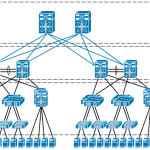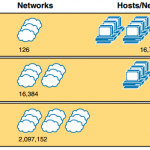CCNA Data Center FAQ: Fundamentals of Ethernet LANs Figure: Single-Building Enterprise Wired and Wireless LAN Q1. In the LAN for a small office, some user devices connect to the LAN using a cable, while others connect using wireless technology (and no cable). Which of the following is true regarding the use of Ethernet in this LAN? a. Only the devices that use cables are … [Read more...]
CCNA DC FAQ: The TCP/IP and OSI Networking Models
CCNA DC FAQ: The TCP/IP and OSI Networking Models Figure: Historical Progression: Proprietary Models to the Open TCP/IP Model Q1. Which of the following protocols are examples of TCP/IP transport layer protocols? (Choose two answers.) a. Ethernet b. HTTP c. IP d. UDP e. SMTP f. TCP Answer: D and F. Of the remaining answers, Ethernet defines both physical and data … [Read more...]
CCNA DC FAQ: Anayzing Classful IPv4 Networks
CCNA DC FAQ: Anayzing Classful IPv4 Networks Figure: Numbers and Sizes of Class A, B, and C Networks Q1. Which of the following are not valid Class A network IDs? (Choose two answers.) a. 1.0.0.0 b. 130.0.0.0 c. 127.0.0.0 d. 9.0.0.0 Answer: B and C. Class A networks have a first octet in the range of 1–126, inclusive, and their network IDs have a 0 in the last … [Read more...]
CCNA DC FAQ: Anayzing Subnet Masks
CCNA DC FAQ: Anayzing Subnet Masks Figure: Simple Subnet Design, with Mask /24 Q1. Which of the following answers lists the prefix (CIDR) format equivalent of 255.255.254.0? a. /19 b. /20 c. /23 d. /24 e. /25 Answer: C. Thinking about the conversion one octet at a time, the first two octets each convert to 8 binary 1s. 254 converts to 8-bit binary 11111110, and decimal … [Read more...]
CCNA DC FAQ: Perspectives on IPv4 Subnetting
CCNA DC FAQ: Perspectives on IPv4 Subnetting Figure: Sample Subnet Plan Document Q1. Host A is a PC, connected to switch SW1 and assigned to VLAN 1. Which of the following are typically assigned an IP address in the same subnet as Host A? (Choose two answers.) a. The local router’s WAN interface b. The local router’s LAN interface c. All other hosts attached to the … [Read more...]
CCNA DC FAQ: Advanced Data Center Storage
CCNA DC FAQ: Advanced Data Center Storage Figure: Storage Virtualization Mapping Heterogeneous Physical Storage to Virtual Storage Q1. Which of the following switches support Console port, COM1, and MGMT interface? (Choose all the correct answers.) a. MDS 9710 b. MDS 9508 c. MDS 9513 d. MDS 9148S e. MDS 9706 Answer: C and D. Console port and MGMT interface are available … [Read more...]
CCNA DC FAQ: VLAN Trunking and Configuration
CCNA DC FAQ: VLAN Trunking and Configuration Figure: Network with One Switch and Three VLANs Q1. Imagine that on Switch 1 you are told to configure port Ethernet 1/1 to participate in VLAN 10. Which commands would enable interface Ethernet 1/1 to participate in VLAN 10? (Choose two answers.) a. switchport mode trunk b. switchport access vlan 10 c. no shutdown d. … [Read more...]
CCNA DC FAQ: IPv4 Routing Protocol Concepts
CCNA FAQ: IPv4 Routing Protocol Concepts Figure: EIGRP Choosing the Longer but Better Route to Subnet 10.1.1.0 Q1. Which of the following distance vector features prevents routing loops by causing the routing protocol to advertise only a subset of known routes, as opposed to the full routing table, under normal stable conditions? a. Route poisoning b. Dijkstra SPF c. … [Read more...]
CCNA DC FAQ: Introduction to Storage and Storage Networking
CCNA DC FAQ: Introduction to Storage and Storage Networking Figure: Storage Connectivity Q1. Which of the following options describe advantages of block-level storage systems? (Choose all the correct answers.) a. Block-level storage systems are very popular with storage area networks. b. They can support external boot of the systems connected to them. c. Block-level … [Read more...]
CCNA DC FAQ: Fundamentals of IPv4 Addressing and Routing
CCNA DC FAQ: Fundamentals of IPv4 Addressing and Routing Figure: Routing Logic: PC1 Sending an IP Packet to PC2 Q1. Which of the following are functions of OSI Layer 3 protocols? (Choose two answers.) a. Logical addressing b. Physical addressing c. Path selection d. Arbitration e. Error recovery Answer: A and D. The network layer defines logical addressing, in … [Read more...]









